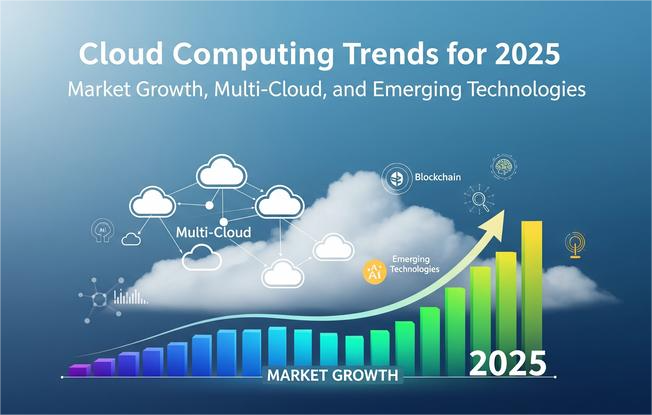
Cloud Computing Trends for 2025: Market Growth, Multi-Cloud, and Emerging Technologies
Introduction
Cloud computing has transitioned from being an optional digital tool to becoming the core infrastructure powering global business operations. As of 2025, the cloud market is not only growing—it’s transforming rapidly, fueled by artificial intelligence, multi-cloud strategies, edge computing, sustainable practices, and specialized industry solutions.
According to recent market reports, the global cloud computing market is expected to surpass $1.3 trillion by the end of 2025, growing at a CAGR of over 17%. This surge is driven by organizations shifting towards digital-first strategies, accelerated by remote work models, 5G adoption, and the rise of AI-powered services.
In this detailed blog, we’ll break down the biggest cloud computing trends of 2025, how they’re shaping the industry, and why businesses must adapt now to stay competitive.
1. Global Cloud Market Growth: The Numbers Behind the Boom Why the Market is Growing Faster Than Ever
The cloud’s role has expanded beyond storage and computing—it is now a platform for innovation. Businesses are using cloud environments to deploy machine learning models, IoT ecosystems, blockchain solutions, and scalable web applications in record time.
Key growth drivers for 2025:
-
Digital transformation acceleration in both SMEs and enterprises.
-
AI-powered services becoming mainstream in the cloud ecosystem.
-
Remote work infrastructure still in high demand post-pandemic.
-
5G networks enabling faster, real-time cloud access.
Notable market prediction:
By 2025, over 90% of enterprises are expected to adopt a mix of public and private cloud solutions.
2. Multi-Cloud Strategies Become the Norm What is Multi-Cloud and Why It Matters
Multi-cloud refers to the use of services from multiple cloud providers—for example, using AWS for hosting applications, Microsoft Azure for AI services, and Google Cloud for analytics.
Benefits of multi-cloud in 2025:
-
Avoid vendor lock-in and maintain flexibility.
-
Optimize costs by selecting the most cost-effective provider for each workload.
-
Improve disaster recovery by having workloads across multiple platforms.
-
Meet compliance regulations by storing data in required geographical regions.
Trend Insight:
By late 2025, it’s expected that over 75% of large enterprises will have a formal multi-cloud strategy in place.
Emerging Multi-Cloud Tools:
-
AI-driven workload placement tools.
-
Centralized cost management dashboards.
-
Unified cloud security frameworks.
3. Edge Computing Moves to the Forefront Why Edge Computing is Gaining Popularity
Instead of sending all data to a centralized cloud, edge computing processes data closer to where it’s generated, reducing latency and improving efficiency.
Key edge computing applications in 2025:
-
Autonomous vehicles requiring millisecond-level response times.
-
Smart cities with real-time surveillance and traffic monitoring.
-
Healthcare wearables monitoring patient vitals instantly.
-
AR/VR experiences with immersive real-time interactions.
Impact on Businesses:
Edge computing, combined with 5G, allows faster decision-making, lower bandwidth costs, and improved reliability, making it a critical investment for companies relying on real-time data.
4. AI-Powered Cloud Services: The Smart Cloud Era From Tool to Core Function
Artificial Intelligence has moved from being just a service offered on the cloud to being a core function of cloud platforms.
Examples of AI in Cloud Computing:
-
Predictive analytics for better decision-making.
-
Automated DevOps pipelines for faster deployments.
-
Chatbots and virtual assistants running on cloud-based AI engines.
-
AI-enhanced cybersecurity to detect threats in real-time.
Emerging AI Cloud Trends:
-
Generative AI APIs integrated into SaaS platforms.
-
AI-driven resource optimization for reducing costs.
-
Custom AI model training on private cloud infrastructures.
5. Sustainable and Green Cloud Initiatives Cloud Computing Meets Environmental Responsibility
As global awareness about climate change rises, sustainability is now a competitive advantage in the cloud industry.
Green cloud trends for 2025:
-
Carbon-neutral data centers powered by renewable energy sources.
-
Energy-efficient cooling systems reducing environmental impact.
-
Server optimization to reduce idle workloads and power usage.
Why it matters:
Customers and businesses alike are now choosing cloud providers based not just on cost and performance, but also on environmental responsibility.
6. Industry-Specific Cloud Solutions Why One Size No Longer Fits All
Cloud providers are increasingly offering specialized cloud environments for different industries.
Examples:
-
Healthcare Clouds with HIPAA compliance and secure patient data handling.
-
Financial Clouds equipped with advanced fraud detection and risk analytics.
-
Gaming Clouds with ultra-low latency for streaming and multiplayer performance.
-
Retail Clouds with AI-driven personalization for e-commerce.
This shift ensures faster deployment, stronger compliance, and better performance for specific business needs.
7. Hybrid Cloud Evolution
While multi-cloud focuses on multiple providers, hybrid cloud blends public and private cloud environments.
Advantages of Hybrid Cloud in 2025:
-
Greater control over sensitive data with private storage.
-
Flexibility to scale workloads to the public cloud when needed.
-
Improved cost efficiency by balancing resources.
Hybrid strategies are especially popular among banks, government agencies, and healthcare providers in 2025.
8. Enhanced Cloud Security with Zero Trust
Security threats are evolving, and so is cloud protection. Zero Trust Architecture (ZTA) ensures that no user or device is trusted by default, regardless of location.
Key security features in 2025:
-
Continuous identity verification.
-
AI-driven anomaly detection.
-
Automated compliance audits.
-
Quantum-resistant encryption algorithms.
With cyberattacks on the rise, cloud security spending is projected to hit $80 billion in 2025.
9. Cloud-Native Development Dominates
Cloud-native is the design and development of applications specifically for cloud environments, using microservices, containerization, and serverless computing.
Why it’s trending:
-
Faster deployment cycles.
-
Higher scalability and resilience.
-
Lower operational costs.
Tools like Kubernetes, Docker, and serverless functions are now industry standards for cloud-native deployments.
10. The Rise of Quantum Cloud Computing
While still in early stages, quantum computing capabilities are being offered via the cloud by companies like IBM, Microsoft, and Google.
Potential applications:
-
Breakthroughs in drug discovery.
-
Optimization for logistics and supply chains.
-
Ultra-secure communication.
Quantum cloud is still niche in 2025, but its growth potential is immense.
Conclusion: Preparing for the Future of Cloud Computing
The cloud computing landscape in 2025 is dynamic, fast-paced, and innovation-driven. From multi-cloud strategies to AI-powered platforms, edge computing, and green initiatives, the cloud is evolving to meet the demands of a digital-first world.
Key takeaways for businesses:
-
Adopt multi-cloud and hybrid strategies for resilience and cost optimization.
-
Invest in AI-powered cloud tools for better insights and automation.
-
Leverage industry-specific solutions for faster compliance and deployment.
-
Commit to sustainability to meet customer expectations and environmental goals.
-
Stay ahead of emerging tech like quantum computing and zero trust security.
By staying informed and agile, businesses can harness cloud computing not just as a technology—but as a growth engine.






